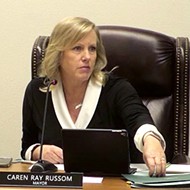Lucia, you got some splainin' to do!
Lucia Mar will lose at least three incumbents, and six candidates want in
By Nick Powell[{
"name": "Ad - Medium Rectangle CC01 - 300x250",
"id": "AdMediumRectangleCC01300x250",
"class": "inlineCenter",
"insertPoint": "8",
"component": "2963441",
"requiredCountToDisplay": "12"
},{
"name": "Ad - Medium Rectangle LC01 - 300x250",
"id": "AdMediumRectangleCC01300x250",
"class": "inlineCenter",
"insertPoint": "18",
"component": "2963441",
"requiredCountToDisplay": "22"
},{
"name": "Ad - Medium Rectangle LC09 - 300x250",
"id": "AdMediumRectangleLC09300x250",
"class": "inlineCenter",
"insertPoint": "28",
"component": "3252660",
"requiredCountToDisplay": "32"
}]
What do a retiree, a real estate agent, and a fluoride activist have in common? They’re just a few of the people trying to squirm into a limited number of seats on the Lucia Mar Unified School District Board of Education.
The November elections promise to drastically change the Lucia Mar board, which oversees San Luis Obispo County’s largest school district: roughly 10,500 students in 17 schools. Four of the district’s seven seats are up for grabs, and only one incumbent is seeking re-election.
Superintendent Jim Hogeboom explained that the board manages a budget of $72 million and sets general goals for the district.
“The board is a big-picture institution, not a collection of micromanagers,” Hogeboom said. “It takes some time for board members to learn that role.”
The district is grappling with major problems, including a steadily shrinking budget, a large population of students who speak English as a second language, and poor test scores that have landed the district in a probationary status of program improvement, Hogeboom said.
The South County district is divided into five areas, and though board members are elected in a district-wide vote, there’s a quota in place requiring that a certain number hail from each area. Thus, the six people vying for four seats will square off in three different elections. Tiffany Alcantara is running unopposed in the Nipomo area.
New Times spoke with the five candidates running in contested areas. There are two seats available for board members representing the Arroyo Grande area. Three people want them.
Mark Millis said he’s running because he believes his unique background would be an asset to the board. He taught American government at Arroyo Grande High School and served as president of the Lucia Mar Unified Teacher’s Association. He was also an Arroyo Grande City Council member and did a stint as mayor.
“I’ve been on both sides of the bargaining table,” Millis said. “I know how the system works.”
Millis is now retired, which he believes is an asset. He said he could use his free time to court local service clubs—Rotary, Lions, Kiwanis, and Elks—and possibly convince them to sponsor schools, help with supplies, and volunteer in classrooms.
He also promised a “zero-based budgeting” approach that would bring scrutiny to every item: how it benefits students and whether it’s truly necessary.
“In my opinion, the board goes to an inordinate amount of retreats and conferences,” Millis said. “There’s a proposal to change the district’s logo, which sounds small, but every sign on every office will need to be replaced—that adds up.”
Colleen Martin is the current board president. She said she started attending board meetings in 1992 as a concerned parent and has been involved ever since. She expressed a sense of obligation to seek re-election.
“I feel qualified and invested in the community,” Martin said. “I’m really proud of our schools.”
Martin believes athletic programs have the power to change lives and she would strive to protect them. She also talked about the importance of advanced-placement classes.
Schools receive money from the state based on attendance. Every absence costs the district precious dollars, so Martin instituted a Saturday school program that allowed students to make up for absences. She claimed that it saved the district more than $100,000.
Two years ago, the board caught a lot of flak for handing out hundreds of pink slips without prior warning, but Martin said that occurred before she was the board’s president.
This year’s budget again forced the board to serve layoff notices, but Martin said it was handled more professionally. Human Resources met with faculty members in advance to explain the temporary nature of the layoffs. Few people complained, and most were hired back, she added.
Real estate agent Cathy Springford said the school board needs more professionalism as it faces increasingly tough choices. She said her analytical skills would help her research the facts and make logical decisions.
Springford has been the president of Grover Heights Elementary School’s Parent Teacher Organization and president of the Grover Beach Chamber of Commerce.
“I naturally rise to the top of organizations to help lead,” Springford said.
She already has inside knowledge of the district’s budget, having served on the budget review committee where she made recommendations to the superintendent. She said most of the easy cuts—those with little impact on students—have already been made.
“We’ll have to increase sports fees and limit spending on buses,” she said. “We’re looking at possible school consolidations as well.”
Springford plans to negotiate an agreement with faculty for conditional salary reductions. Ideally, voluntary pay cuts would reduce the need for future layoffs. She added that she would “absolutely” be willing to get rid of bad teachers and that the district needs to devise a way to test and measure teacher performance.
“As parents, we all know which teachers are good and which ones are bad,” Springford said. “Why do we keep them?”
In the Oceano area, two candidates are vying for one board seat.
Vern Dahl has been in public office for the last eight years with the Oceano Advisory Council and the South County Sanitation District. His background is mostly in accounting, which he said makes him an ideal candidate.
“Dealing with budgets is pretty second nature to me,” Dahl said.
Dahl said he’s always had an interest in education, and now that his daughter is enrolled in the district, he wants it to be as strong as possible.
“I’m not planning on being a disruptive force,” he said. “The board and staff need to work together with a common goal.”
His plan centers on keeping as much money near the classroom as possible, while reducing the size of middle management.
Adelina “Nina” Gabriel has a different take on the issues at hand.
“It’s been shown that having fluoride in the water decreases I.Q. scores,” said Gabriel, who has a degree in kinesiology and health. “There’s a real disconnect in spending money on education and putting fluoride in drinking water at the same time.”
She admitted that the South County doesn’t use fluoride, but said surrounding areas, which students frequent, do. She wants to send documents about the issue to legislators in the hopes that they might listen to a member of a school board. She also hopes to improve the quality of school breakfasts and encourage local farms to donate produce.
“Kids need to be healthy in order to retain information,” she said. “Toxins affect small bodies more quickly.”
Gabriel said she’s compiled a list of foundations that provide grants for the arts, and she believes she could convince them to donate to the Lucia Mar district. She was once the secretary for the department of art and design at Cal Poly and is now working as a community advocate.
Intern Nick Powell can be reached through Executive Editor Ryan Miller. Send comments to rmiller@newtimes
slo.com.
Latest in News
Readers also liked…
-

Coast Unified teachers upset over new position's salary and qualifications
Oct 20, 2022 -

SLO police identify alleged driver who hit and killed couple
Dec 22, 2022 -

When the levee breaks: Oceano residents, county officials walk a tightrope of regulations to manage Arroyo Grande Creek, which some say led to the levee's failure in January
May 18, 2023








